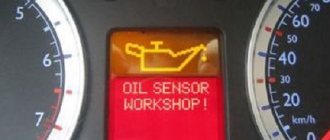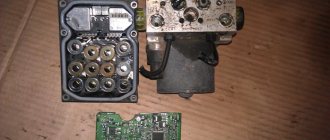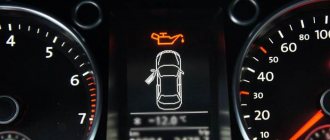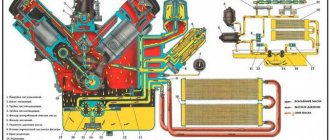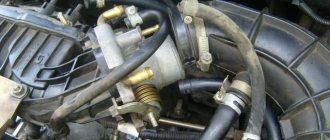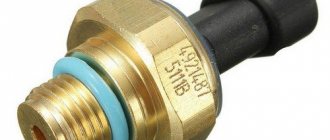Oil light when the engine is running and there is a sufficient level of lubricating fluid, it is in an inactive state, that is, it does not light up. If it lights up, this indicates a malfunction, such as a low oil level in the crankcase, low pressure in the engine oil system (for example, the oil filter is clogged, the oil pump is not working well), the oil level sensor has failed, and some other less common. In any case, if the oil pressure light is on or blinking, you must first check the lubricant level. If its indicator is normal, then you need to look for the reason that caused such an indication and eliminate it.
It is extremely undesirable to operate a machine with a low oil level, since under such conditions the engine experiences enormous mechanical and thermal overloads, which reduces its service life and can partially or even completely disable it. If at the moment it is not possible to add oil to at least the minimum (or preferably medium or two-thirds to full) level, then, as a last resort, you can with minimal loads, that is, at medium speeds (not at very low, and not at high speed!) and at low speed drive to a car shop or service center, where you can top up (or completely replace) the engine oil. However, keep in mind that if the store is far away, it is better to leave the car where it is and add oil to it later.
When the oil light (oil can) is on on the panel, it is better to stop driving until the cause is found out, otherwise you can “catch a wedge” of the engine.
What does the lamp indicate?
The indicator light on the dashboard reacts strictly to engine oil pressure. Due to the level being reduced within reasonable limits, the signal will not appear on the panel. The exception is the loss of 2/3 of the lubricant when the oil intake of the pump begins to pick up air and crankcase gases. Then the pressure in the lubricating channels will inevitably drop, to which the sensor will react and the light will light up.
The oil receiver is specially installed at the bottom of the pan so that the system operates when there is a lack of lubrication
The circuit, signaling problems with lubrication of the power unit, consists of parts that also periodically break. So a flashing lamp does not always mean fatal engine failure. But if it lights up on your car, then you need to act like this:
- Stop moving.
- Turn off the engine.
- Check the lubricant level and, if necessary, add up to normal. The lubricant level in the car engine is checked with a special dipstick
- Topping up did not work - transport the car to the garage or to a car service using a tow truck or in tow.
- If the indicator light is intermittent (flashing), then move to the repair site under your own power at low speed. Monitor the coolant temperature gauge and pressure light: when it stops flashing and lights up, immediately turn off the engine.
In your garage, you can find the cause of the alarm if you follow the steps below.
Oil pressure light comes on at idle, check methods
Now let's talk about the case when the low oil pressure warning light comes on while the engine is idling. Below we present available methods for identifying malfunctions, which will generally be useful in diagnosing the condition of the engine lubrication system and engine oil pressure.
- If the oil pressure light comes on, then you should check the engine oil level in the engine and its condition. If the level drops, add oil. A suspicious condition of the oil (black color, excessive thickness) will require thorough flushing of the oil system and subsequent oil change. The smell of gasoline/diesel, emulsion on the oil filler cap, or severe dilution of the engine oil will indicate problems with or cracks. On a working engine, the combustion chambers should be sealed, fuel and antifreeze should not enter the lubrication system.
- The oil pressure lamp may come on at idle immediately after changing the oil during the first start. In this case, the warning light may remain on for 10, 15 or even 20 seconds. If after the specified period of time the low oil pressure lamp does not go out, then you should check the oil filter. The product may be of poor quality, poorly screwed (oil leaks are noticeable in the area where the filter is attached) or defective.
- Check the oil pressure sensor. The oil pressure level at idle speed at around 800 - 900 rpm should not be less than 0.5 kgf/cm2. It is also worth noting that emergency oil pressure sensors on different engines may have different response ranges, which on average range from 0.4 to 0.8 kgf/cm2. This means that if there is a sensor designed to operate at 0.7 kgf/cm2, already during a pressure drop to 0.6 kgf/cm2 the sensor will turn on the emergency oil pressure lamp. This is done for conditional notification of a decrease in pressure in the line of the internal combustion engine lubrication system.
The initial check of the sensor should be done by slightly increasing the crankshaft speed (1000-1100 rpm). In other words, if the oil pressure light goes out when you press the gas, then the following options are possible:
- idle speed is too low (the light blinks at idle);
- low oil pressure in the lubrication system;
- malfunction of the oil pressure sensor;
- engine malfunction;
To accurately measure the oil pressure in the engine, you need to unscrew the sensor and install a pressure gauge in its place. Also, one should not exclude false alarms of the oil pressure sensor at idle speed, which may occur due to contamination of both the device itself and the engine oil channels. In this case, you will need to clean the sensor and clean the lubrication system channels.
As for engine breakdowns that lead to a decrease in oil pressure, indirect signs are increased consumption of fuel and engine oil, the engine emits blue or bluish smoke. In such cases, the oil pressure lamp lights up at idle, taking into account the warmed-up engine. This occurs due to the fact that the heated lubricant liquefies and flows freely through the gaps between various parts (liners, shaft journals, etc.).
Another reason could be a malfunction of the oil pump itself. During engine operation, wear of the gear pair and the internal and external surfaces of the oil pump housing may occur. Let us add that engineers set the pump’s performance to be such that it initially allows you to create pressure higher than that recommended for the motor. It turns out that the pump always pumps oil “with a reserve”. In this case, the oil pump is driven from the crankshaft, that is, the oil pressure depends on the speed (crankshaft rotation speed).
As you know, at idle the crankshaft speed is minimal. At the same time, the oil pump also develops a minimum pressure. As a result, a relatively small deviation can lead to the oil pressure lamp coming on at idle, while when the speed rises and the oil pressure in the lubrication system increases, the problem of the low oil pressure warning lamp on the dashboard coming on may not appear.
Engine oil pressure: what it depends on, how to measure it correctly. What is the oil pressure on different engines in idle mode and under load.
Why there may be low oil pressure in the engine, the oil pressure light blinks at idle or under load. Fault diagnosis and repair.
Why problems arise
For diesel and gasoline units, there are several main reasons that cause the sensor light, which is responsible for pressure in the system, to light up.
All the reasons for this phenomenon can be divided into malfunctions that can be eliminated on your own, and serious problems. Among the common simple faults we note:
- insufficient amount of oil;
- non-working state of the sensor;
- use of low-quality motor oil;
- The oil filter is clogged with dirt.
For complex cases leading to a decrease in pressure, read:
- significant wear of the main and connecting rod bearings of the crankshaft and camshaft;
- problems with the oil pump are caused by wear or damage to the cover, gears, and housing;
- malfunctions of the pressure reducing valve - decreased elasticity, presence of foreign particles under the cover, wear of the spring;
- change in engine oil viscosity.
Main reasons
- Minimum oil level. Today this reason is considered one of the most common. When using the vehicle regularly, it is recommended to carefully monitor the oil level and try to notice various drips on the engine body. Any, even the smallest oil stains under the car are sufficient reason to check the oil system.
- Using bad filters. A certain amount of oil should always remain in the filter, regardless of the stop of the power unit. This is required so that the effect of “engine oil starvation” does not form. As practice shows, many low-quality filters do not retain oil, so it flows into the crankcase without any problems. The only way to cope with this situation is to replace the filter with a better one.
- Wiring fault. Very often the oil pressure light stays on for a long time due to wiring problems. It is located on the panel and connected to the sensor via a wire. If the oil pressure drops below a certain level, the sensor closes the light to ground. When the pressure becomes normal, the contacts open and the light goes out. However, if the sensor itself is broken, the light will not turn off. In this situation, it is necessary to conduct a thorough diagnosis, replace the wiring, as well as parts that have failed.
- Reducing valve failure. If the pressure level is minimal, then the working pressure relief valve will be located in the closed position. If it freezes or gets stuck in the open position, the required pressure will not be generated in the system, and accordingly, the light will be constantly on.
- The pump screen is clogged. It is this part that is responsible for effectively protecting the pump, as well as the power unit, from the penetration of all kinds of debris onto various surfaces. Hard chips, dirt, dust and other objects - all this has a negative impact on the surface of numerous parts. If the oil is clean, free of all kinds of contaminants, then it easily passes through the mesh. At this moment, the sensor is set to a “quiet state,” which confirms the normal functioning of the motor. However, when the oil becomes dirty and moves poorly through the filter, it is not possible to provide the required pressure. To solve this problem, it is necessary to replace the oil pan.
- Oil pump failure. If this device cannot guarantee the pressure necessary for high-quality lubrication, then the contacts are closed, accordingly, the light will constantly signal to the driver that there is a fairly serious malfunction in his vehicle.
If the pressure light is dim, you should check the wiring or replace the light bulb itself.
You can learn about the oil pressure in your car from the article What is the oil pressure.
How does the oil sensor work and why can it fail?
Now let's consider the situation if you are on the road and the low pressure indicator has triggered.
The very first thing you need to do is stop the vehicle and turn off the engine. As soon as it cools down, you will have to check the lubricant level in the system. There is a special dipstick under the hood for this purpose. It is wiped dry and immersed in its original place. It is quite possible that the level will be below the minimum level. This means that somewhere there is a leak or depressurization of connections. You can set off again only after adding oil to the engine. If the lamp continues to light after starting and does not go out subsequently, it makes sense to think about towing the car to the nearest service station or to a trusted auto mechanic. The matter may turn out to be quite serious, so it is advisable to conduct the examination in a calm environment. Since we have already said that the causes of low pressure may be associated with a faulty sensor, it would be useful to understand the principle of operation of this device. There are certain contacts inside it. Until the ignition is turned on, there is no pressure in the system, so the contacts are closed. When you turn the key and turn on the ignition, but before the starter starts, the warning lamp should be on. If this does not happen, then there may be some kind of malfunction. Maybe the light bulb itself simply burned out, or maybe the contacts were broken or the sensor itself failed. As soon as we start the engine, the contacts open, leading to the light bulb going out.
How does the oil pressure indicator work?
Controlling the pressure in the lubrication system is simple. A sensor is installed in one of the channels of the lubrication system that responds to changes in pressure. This sensor is connected by an electrical circuit to the warning light on the dashboard.
The operating principle of this scheme is also simple. If there is no pressure, the sensor closes the circuit, so when the ignition is turned on, the light comes on, indicating that the electrical circuit is working. After starting the engine, the oil pump pumps oil, so the pressure in the channels increases. When a certain value is reached, the sensor opens the circuit and the light goes out.
The sensor itself is set to the minimum pressure required for normal engine operation. This indicator differs on different models; on some engines the working indicator is 0.3 - 0.4 kgf/cm2 at idle, at speeds of 2000-3000 and more than 0.5-0.7 kgf/cm2.
When operating the machine, a problem arises when the pressure indicator lamp lights up while the engine is running, and its light may vary. For some, the control lights up at idle and the glow is dim, while for others the signal is bright and appears at medium and high speeds. If the lamp lights up at idle and goes out when driving, then you need to look for the cause.
And under whatever conditions the warning system is triggered, measures must be taken immediately. The lubrication system directly affects the performance of the engine and its malfunction will result in serious damage.
The first thing the driver should do when the lubrication pressure light comes on is to stop driving and turn off the engine. The next step is to identify the reason for the alert.
Using the “wrong” oils
There is an assertion among motorists that if the engine oil does not match the specific type of engine, it can lead to serious damage. How true is this?
The main criterion for oil is viscosity. On canisters it is designated by the letter “W”. The first number before the “W” indicates viscosity at low temperatures. The lower the number, the colder the climate you can start the engine without the risk associated with the lack of lubrication on the rubbing surfaces.
The second number indicates the viscosity when the engine is warm. The oil temperature in the lubrication system reaches 100-150 °C. The more technologically advanced the engine, the lower the viscosity should be when heated. Each manufacturer indicates the required oil viscosity in the vehicle service book.
Do not assume that more expensive oil is better for the engine. The main criterion is the manufacturer's requirement.
Why does the oil pressure light come on in VAZ 21142115
There are several likely reasons why this car light suddenly comes on. And only based on an accurate determination of the cause can the necessary actions be taken to eliminate the malfunction.
The indicator may light up in two cases:
at engine idle speed;
when the car is moving.
Each of these cases has its own causes of malfunctions.
The light came on at idle
The oil pressure light may come on (or blink) at idle, and if you press the gas pedal, the icon will immediately go out. In this case, the most likely causes of malfunctions are the following:
the crankshaft liners are worn out: the oil pressure will drop due to the fact that the gap between the thinned liner and the car’s connecting rod has increased;
the oil receiver mesh is severely clogged: one of the most common reasons why a light bulb suddenly lights up. Various types of sediment are gradually deposited on the surface of the engine sump. At the moment when there are too many deposits, the pump can no longer supply enough oil to operate the engine;
wear or any problems in the oil pump: another probable reason why the indicator may light up on a VAZ 2114/2115. Due to a breakdown of the pump itself or any part of it, oil does not enter the engine in the required quantity;
the sensor is faulty: it is quite possible that the oil level and the engine itself fully meet their basic characteristics, and the problem lies in the sensor;
the wiring is shorted: problems in the car’s electronic system can also cause the engine oil supply system to not operate correctly.
The oil can indicator light came on while driving.
In cases where the oil pressure light suddenly comes on while the car is moving, it is advisable to stop immediately. Probably the following failure or breakdown occurred:
the oil level in the engine unit is below the Min mark;
the oil filter could be clogged - this leads to the fact that the pressure invariably decreases;
it's time to change the oil - in cases where the car owner does not replace the substance in the engine for a long time, it loses its working properties.
Special malfunctions of VAZ engines
These problems are common to almost all types of engines used in cars, including domestic ones.
But there are also specific faults that occur only on certain cars.
On classic models VAZ-2106, 2107, the pump is driven from the timing chain via a drive gear and a drive roller.
A common problem in the malfunction of the lubrication system is wear of the gear sector on the gear or shaft. Replacing these elements allows you to get rid of problems.
As for modern cars, from the VAZ-2108 to the VAZ-2115, they have a direct pump drive, from the crankshaft gear.
The absence of intermediate elements in the design has increased the reliability of the drive, so the problems that arise in the engines of classic VAZs do not occur in modern cars.
Video of oil pressure light blinking
I myself am an experienced motorist and I know when the oil pressure light starts blinking, it’s always not good. I'll list them point by point.
1) Excessive engine wear. This means that the engine has high output and the oil pressure is below normal levels. Usually happens after a long mileage of the engine. BUT I don’t have that much mileage, the car is only in its second year.
2) The oil is not suitable for the engine. It happens that the oil is not suitable for the engine. This happened on our “classic” VAZs when they filled in oil that was too “thin” for them. At idle speed when the engine warmed up, the lamp began to blink indicating that the pressure in the engine was not enough. You just need to change the oil. But I have the oil that the manufacturer himself recommends, and made under his supervision (GM oil).
GM oil
3) Insufficient oil level. Just pull out the oil dipstick and check the level. It should be at average and not higher than “maximum”. If the oil is above the maximum mark, then it needs to be removed; more details in the article - excess oil in the engine. If the oil level is below the level, simply add it up to the norm to avoid oil starvation of the engine.
normal level
BUT my oil is always fine, I check it every day.
4) The oil pressure sensor is faulty. The oil pressure sensor is malfunctioning and, even though the oil level and pressure are normal, it provides incorrect information to the vehicle’s instruments.
In general, after I arrived at the official station and showed the fault, I was advised to add some oil to the engine. I bought exactly the same oil as mine, but the situation did not improve, the lamp still blinked.
add oil
into the engine neck
Then they took my car to the station for detailed diagnostics.
An hour later (+ free car wash) it turned out that the oil pressure sensor had failed. I just felt better, because engine repair is very serious, and an oil sensor costs pennies. At VAZ, I changed it in half an hour. But then it turned out that the Chevrolet Aveo oil pressure sensor is located at the bottom and changing it is not so easy. Therefore, my car was left for four hours, I agreed to pick it up in the morning.
The role of the oil pressure indicator
The red light, marked on many cars with the image of an oil can, was added to the dashboard for a reason. It is connected to a common electrical circuit with a sensor mounted in one of the channels of the engine lubrication system. When the element detects a pressure drop below a critical level, the circuit closes and the lamp flashes red, informing the driver of an emergency malfunction.
The signal from the red lamp with the image of an oil can indicates a malfunction of the engine lubrication system
The purpose of the emergency lamp is to warn the car owner in time about the engine's oil starvation. If for various reasons it does not light up or the driver ignores the red “oil can” signal on the instrument panel, then the following consequences may occur:
- due to lack of lubrication, the crankshaft journals wear out, the sliding bearings (liners) may rotate and finally jam; As a result of oil starvation, wear appears on the crankshaft journals
- In the absence of oil, the piston skirts will overheat and expand in volume, leaving scratches and scuffs on the cylinder walls; A poorly lubricated piston heats up and leaves scuff marks on the cylinder wall
- the camshaft bearings located at the highest point of the engine will fail; Without lubrication, the camshaft bearings quickly fail
- the service life of the remaining rubbing parts will be sharply reduced.
Insufficient amount of lubricant or its absence in any case leads to breakdown and costly repair of the power unit. A timely signal on the dashboard will help avoid this.
The system failure indicator is on
Almost every car owner has encountered a situation where the red lubricant pressure lamp on the instrument panel lights up. But not all drivers know what to do in such a case.
After all, the situation can occur at any moment - both while the vehicle is moving and at idle speed. Definitely, if this problem occurs, the car requires repair work.
There are many reasons for the occurrence of an indicator signal. The driver is recommended to adhere to a certain rule: you cannot continue driving if the indicator lights up.
Neglecting the recommendation can lead to irreversible consequences, namely major damage to the car. The optimal solution in this situation is to call a tow truck and go to a car service center to diagnose the control system.
Motor oil, in addition to its main function of lubrication, acts as a cooling agent. If the pressure in the power unit decreases, then, consequently, the temperature of the mating elements increases.
The motor begins to wear out, that is, under extreme operating conditions. It is worth noting that hot oil loses its positive properties and loses its function of creating a special film on engine parts and mechanisms.
